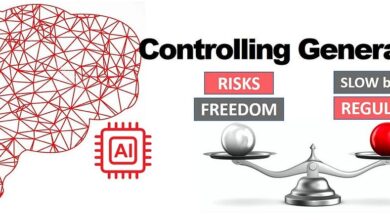Embracing AI At Work Is A Mindset Game

AI (Artificial Intelligence) concept. Deep learning. GUI (Graphical User Interface).
Asana’s Work Innovation Lab has just released the State of AI at Work 2024 report, and it is one of the most comprehensive pieces of research regarding generative AI to date. The report discusses surprising use cases for the technology at work, breaks down the path to widespread AI usage, and explores adoption mindsets and the journey organizations must embark upon. This report moves the research and discussion beyond who is using AI and for what purpose and gets into the nuance of what it means, how it feels, and what opportunities it unlocks. All statistics referenced throughout the rest of this article are from Asana’s report.
A new way for companies to assess where they are on their AI journey
Companies are at an AI tipping point. More than half (52%) of knowledge workers now use generative AI weekly — a 44% increase in just nine months. People are using it whether companies have a plan for AI or not — and only 31% of companies have a formal AI strategy in place. Those companies without a plan had better pick up the pace.
A good starting point is to figure out where they are on Asana’s AI maturity model, which is detailed in the report. It consists of five stages: skepticism, activation, experimentation, scaling, and maturity. Rebecca Hinds, head of the Asana Work Innovation Lab, discusses the maturity model and the highlights of the report.
When it comes to adoption, “It’s not that everyone should be at stage five,” Hinds says. “Rather, it’s about how you get to that next step of the maturity curve.”
That journey itself brings opportunities and challenges. “What stood out to me was how the concerns change as you move step to step,” says Hinds. “Concerns are inevitable, and they are healthy, but if you are less mature in your implementation of AI, the concerns are going to center on comprehension and understanding of how to use the technology. As companies reach those more mature stages, concerns shift toward ethics and responsible AI.”
This is a helpful guideline for how organizations should tailor their approach. Less mature companies should probably focus on comprehension, whereas those who have fully embedded AI will be more focused on ethics and re-designing jobs.
AI adoption is about mastering mindsets
55% of workers feel optimistic about using generative AI compared to just six months ago, and that optimism undoubtedly fuels experimentation. The top use cases for AI at work are email generation, information summarization, content generation, technical writing, ideation and brainstorming, and data analysis.
“The use case that stood out to me was brainstorming,” says Hinds. “There’s this overwhelming narrative that the one aspect of human work AI can’t take over is the creative thinking, brainstorming, and ideation.” A theory the study posits is that generative AI can help overcome “blank page syndrome” as well as provide feedback on initial ideas before they are shared in a group brainstorming setting.
Leadership modeling is one of the most important tools for any behavior change initiative, and executives are embracing AI at higher rates than people at all other levels of the organization. While 69% of executives report using generative AI at work at least weekly, only 43% of individual contributors do the same.
“Executives are more confident in their own skill set, and they are less concerned about job replacement,” says Hinds. “This is largely because they are responsible for strategic work that has yet to be replaced — most skill displacement at the moment is with administrative tasks.”
“So much of the learning at the moment is happening through personal experimentation and personal exposure, and a lot of executive learning is coming from conferences and that exposure has been helpful for executives to at least understand potential use cases of the technology,” she says. This highlights a resource gap in training provided for executives and individual contributors. Executives are twice as likely to say that their organization has allocated budget for generative AI training.
Companies need to train their people and encourage experimentation, but framing messages correctly is incredibly important to overcome hesitancy in adoption — especially in unfamiliar areas. 64% of knowledge workers have little to no familiarity with the generative AI tools they could use at work. They’re less enthusiastic about it as well, with only 50% being excited about the possibilities of AI vs 67% of executives.
“The way we frame technology in the stories we tell and the metaphors we use as we bring them into our organization matters — and it matters significantly for those individual contributors,” says Hinds. She also isolates the word “artificial” as particularly problematic. “It seems less real, more scary, and more like a black box. Why can’t we replace it with ‘amplified’ or ‘augmented’ to convey that this technology is meant to amplify our human skills? It’s not meant to be in conflict.”
Where’s the best place to start embedding AI throughout the organization?
Hinds points out that AI is only going to improve. Therefore, this is the prime time to experiment with AI and learn with the technology as new models develop. You can’t just dabble and expect to see results, though. 39% of “dabblers” report productivity gains whereas 89% of daily users report productivity gains. The message to employees is: start experimenting.
For companies, Hinds also has a clear starting point. “One step you can take, no matter where your organization is on its AI journey, is to establish a set of principles for AI. Often executives will push back against having a concrete policy for AI, saying that it’s too early for official guidelines, but even if you’re super early on your journey, you can put together a list of principles in terms of how you see the role AI plays in your organization. What are your underlying beliefs in how the technology should be used?”
Hinds emphasizes that humans are at the heart of this. “We should be building for human and AI teams and adopting a human-centric approach.” Even if they don’t understand the technology, they still need to know the intention of bringing it into the workplace. “When people see AI as a teammate rather than a tool, they’re interacting with it differently. They tend to think more broadly about the use cases and how they can work with the technology — not just what it can do for them.”



